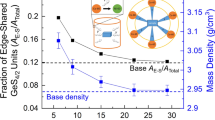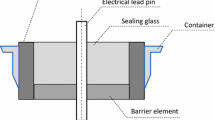The possibility of glass formation in the four-component system La2O3–Al2O3–B2O3–SiO2 with La2O3 molar content 27% was studied. The ratios of the components for which the glasses are most stable with respect for amorphous phase separation and crystallization were determined. The composition range bounded by the limit values of the molar content of the components — 7 – 30 SiO2, 8 – 25 Al2O3, and 32 – 50 B2O3 — makes it possible to obtain glass with refractive index nD to 1.74, dispersion coefficient vD to 57, and density ≤ 4.15 g/cm3. The manufacturability of these glasses creates the prerequisites for developing materials with different combinations of optical constants by modifying the matrix with a wide range of dopants.





Similar content being viewed by others
Notes
Here and below, molar content of the components, %.
References
V. E. Galant and E. B. Nosyreva, “High refractive-index glasses for cinematography,” Steklo Keram., No. 11, 10 – 12 (1991); V. E. Galant and E. B. Nosyreva, “High refractive-index glasses for cinematography,” Glass Ceram., 48(11), 498 – 502 (1991).
T. A. Nedospasova, S. G. Kozhevatkin, M. V. Artamonova, and V. M. Molev, “Optical glass with refractive index of 1.75 and high specific refraction for spectacle optics,” Steklo Keram., No. 6, 13 – 16 (1995); T. A. Nedospasova, S. G. Kozhevatkin, M. V. Artamonova, and V. M. Molev, “Optical glass with refractive index of 1.75 and high specific refraction for spectacle optics,” Glass Ceram., 52(6), 143 – 146 (1995).
Catalogue of Colorless Optical Glass [in Russian], Lytkarino Optical Glass Plant. URL: http://lzos.ru/content/view/77/29/(access date March 27, 2018)
Optical Glass 2018, SCHOTT, URL: http://www.schott.com/advanced optics/english/download/index.html (access date March 27, 2018).
Catalog Optical Glass, HOYA, URL: http://www.hoyaopticalworld.com/english/ (access date March 27, 2018).
Catalog Optical Glass, OHARA, URL: http://www.oharacorp.com/\catalog.html (access date March 27, 2018).
S. V. Nemilov, Optical Materials Science: Optical Glasses [in Russian], SPbGU ITMO, St. Petersburg, (2011).
I. N. Chakraborty, J. E. Shelby, and R. A. Condrate, “Properties and structure of lanthanum borate glasses,” J. Am. Ceram. Soc., 67(12), 782 – 785 (1984).
K. Terashima, S. Tamura, S. H. Kim, and T. Yoko, “Structure and nonlinear optical properties of lanthanide borate glasses,” J. Am. Ceram. Soc., 80(11), 2903 – 2909 (1997).
I. Kratochvilová-Hrubá, I. Gregora, J. Pokorny, et al., “Vibrational spectroscopy of LaBSiO5 glass and glass-crystal composites,” J. Non-Cryst. Solids, 290, 224 – 230 (2001).
V. N. Sigaev, P. Pernice, A. Aronne, et al., “Influence of alumina addition on crystallization and texturing behavior of LaBGeO5 glass,” J. Non-Cryst. Solids, 352(21 – 22), 2123 – 2128 (2006).
S. I. Bananyarly and R.N. Kasumova, “Glass formation in the BaO–La2O3–B2O3 system,” Inorg. Mater., 39(9), 978 – 980 (2003).
S. Iftekhar, J. Grins, and M. Edén, “Composition-property relationships of the La2O3–Al2O3–SiO2 glass system,” J. Non-Cryst. Solids, 356(20 – 22), 1043 – 1048 (2010).
S. Iftekhar, J. Grins, P. N. Gunawidjaja, and M. Edén, “Glass formation and structure–property–composition relations of the RE2O3–Al2O3–SiO2 (RE = La, Y, Lu, Sc) systems,” J. Am. Ceram. Soc., 94(8), 2429 – 2435 (2011).
S. F. Wang, C. M. Lu, Y. C. Wu, et al., “La2O3–Al2O3–B2O3–SiO2 glasses for solid oxide fuel cell applications,” Int. J. Hydrogen Energy, 36(5), 3666 – 3672 (2011).
I. A. Levitskii, M. V. Dyadenko, and L. F. Papko, “Production of optical glasses based on the system BaO–La2O3–Al2O3–B2O3–SiO2,” Steklo Keram., No. 10, 3 – 6 (2011); I. A. Levitskii, M. V. Dyadenko, and L. F. Papko, “La2O3–Al2O3–B2O3–SiO2 glass production,” Glass Ceram., 68(9 – 10), 315 – 318 (2011).
V. I. Savinkov, V. N. Sigaev, N. V. Golubev, et al., “Borogermanate glasses with a high terbium oxide content,” J. Non-Cryst. Solids, 356(33 – 34), 1655 – 1659 (2010).
I. N. Chakraborty and D. E. Day, “Effect of R3+ ions on the structure and properties of lanthanum borate glasses,” J. Am. Ceram. Soc., 68(12), 641 – 645 (1985).
Author information
Authors and Affiliations
Corresponding author
Additional information
Translated from Steklo i Keramika, No. 2, pp. 3 – 7, February, 2019.
Rights and permissions
About this article
Cite this article
Alekseev, R.O., Savinkov, V.I. & Sigaev, V.N. Investigation of Glass Formation and the Properties of Lanthanum-Aluminum-Borosilicate Glasses with High Lanthanum Oxide Content. Glass Ceram 76, 45–48 (2019). https://doi.org/10.1007/s10717-019-00130-5
Published:
Issue Date:
DOI: https://doi.org/10.1007/s10717-019-00130-5




